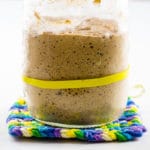Rye Sourdough Starter
Creating your own rye sourdough starter from scratch is a rewarding process, and it's a whole lot easier than you may think. Here's how to do it.
Servings: 1
Ingredients
- 100 grams water per feeding
- 100 grams rye flour per feeding
Instructions
Day One
- Weigh your jar and write down how much it weighs. That way you'll always be able to calculate the weight of your starter by subtracting the weight of the jar.
- Pour the water into the jar.
- Spoon in the flour.
- Stir it very well, until there's no more dry flour. Be sure to check the bottom of the jar for any dry flour and stir it into the mix.
- Use your spoon to gently pack down the starter into a relatively even layer. This will help you see how much it grows throughout the course of its feeding.
- Place a rubber band or elastic hair tie around the jar at the level of the top of the starter.
- Position the lid and screw it on loosely. This allows the starter to exhale carbon dioxide (a byproduct of yeast fermentation).
- Place starter on the counter or anywhere you like at warm room temperature. Don't expect any visible activity today.
Day Two
- Remove all but 100 grams of the starter.
- Pour in 100 grams of water and stir it up to break up the starter.
- Spoon in 100 grams of flour. Stir well until there is no dry flour anywhere in the jar.
- Use your spoon to gently pack down the starter into a relatively even layer.
- Adjust the placement of the rubber band to the level of the top of the starter.
- Position the lid and screw it on loosely.
- Place starter on the counter or anywhere you like at warm room temperature. If you're using good-quality flour and it's not freezing cold in your house, you're likely to see some activity today.
Days 3-5
- On days three, four, and five, you will feed your starter twice per day, at approximate 12-hour intervals.
- Follow the steps for day two above, but do them once in the morning and once at night.
- On these days, you'll have lots of discard. These are great days to make my favorite crackers.
- By day five, if you're using really good flour, you should see the starter at least doubling in size between feedings. If you are seeing plenty of activity but not yet a doubling, don't worry. Continue feeding twice per day for the next few days.
- If you're not seeing much activity at all, refer to the troubleshooting section above.
- You'll know your starter is ready to leaven bread when it passes the float test.
Notes
- The better your flour, the easier time you'll have getting up and running with a new sourdough starter. Generally speaking, stone milled flour from a smaller local source will have all sorts of things going for it, from the soil it was grown in (the source of many of those microbes we're looking for) to the way it's milled to preserve more of its nutrients.
- I've been using Wrens Abruzzi Rye from Barton Springs Mill for the past year, and it's wonderful. It's not local to me, but in late March of 2020 it was one of the only sources I could find easily, and I fell in love with it. They ship nationally, but I encourage you — and my future self — to find a source local to you. You can use any flour to make a starter, including all-purpose flour from the grocery store, but you can't beat the ease and robustness of a starter made and maintained with excellent-quality rye.
- Use room-temperature water — about 75°F is ideal. We have a water filter, and I make use of it in this process. If you don't, it's generally fine to use tap water. If your tap water has a strong chemical smell, you might want to leave it on the counter overnight before using to let any additives settle to the bottom, then pour the water off the top to use in your sourdough-making.
Nutrition
Serving: 1 | Calories: 44kcal | Carbohydrates: 9g | Protein: 1g | Sodium: 1mg | Fiber: 1g
QR code
Scan this QR code with your phone's camera to view this recipe on your mobile device.
